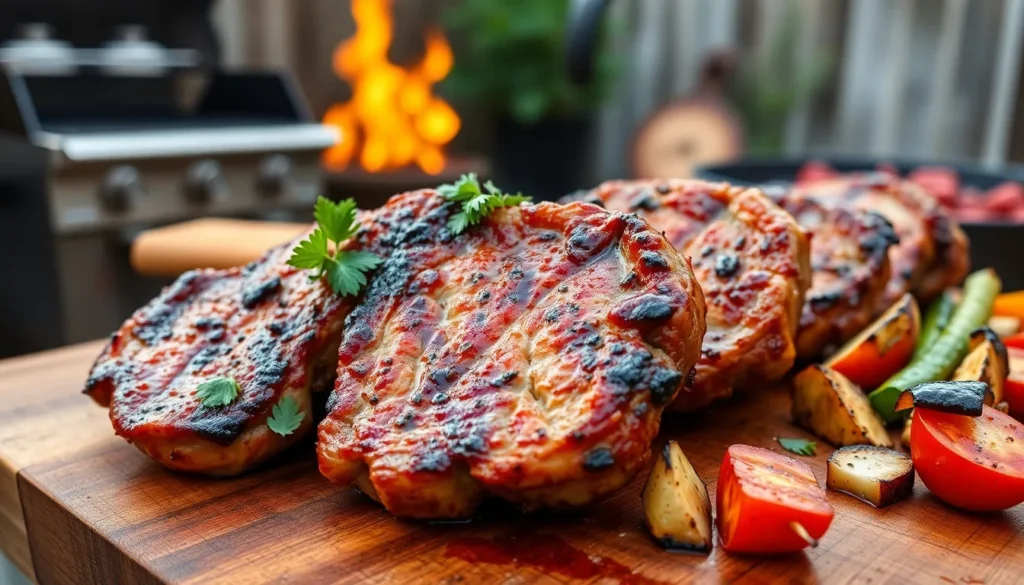Nothing beats the smoky aroma and tender juiciness of perfectly grilled BBQ pork chops. We’ve all been there – standing at the grill wondering how to transform tough, dry pork into mouthwatering masterpieces that’ll have your family begging for seconds. The secret isn’t just in the cooking technique; it’s about choosing the right cuts, mastering the perfect seasoning blend, and understanding when to apply heat versus when to let patience work its magic.
Whether you’re a backyard grilling novice or a seasoned pitmaster, we’re about to share the game-changing methods that separate good pork chops from absolutely incredible ones. From bone-in ribeye chops that practically fall off the bone to center-cut beauties with that perfect pink interior, we’ll show you exactly how to achieve restaurant-quality results every single time.
Get ready to discover why these techniques will revolutionize your grilling game and make you the neighborhood BBQ hero.
Choose the Right Cut for the Best BBQ Pork Chops
Selecting the perfect pork chop cut sets the foundation for exceptional BBQ results. We’ve discovered that the right choice can make the difference between dry, tough meat and succulent, flavorful chops that fall off the bone.
Bone-In vs. Boneless Pork Chops
Bone-in pork chops deliver superior flavor and moisture retention during the grilling process. The bone acts as a natural heat conductor, creating even cooking throughout the meat while preventing overcooking. We recommend bone-in cuts like ribeye chops, T-bone chops, and center-cut chops for their enhanced taste profiles.
Boneless pork chops cook faster but require more attention to prevent drying out. These cuts work best for quick weeknight dinners when you’re pressed for time. Boneless options like sirloin chops and tenderloin chops offer convenience but need careful temperature monitoring to achieve optimal results.
Marbling patterns differ significantly between bone-in and boneless varieties. Bone-in cuts typically feature more intramuscular fat, which bastes the meat naturally during cooking. This self-basting effect creates those coveted juicy textures we all crave in perfect BBQ pork chops.
Thickness Matters for Juicy Results
Thick-cut pork chops measuring 1 to 1.5 inches provide the best balance of cooking control and moisture retention. These cuts allow us to develop a beautiful sear on the outside while maintaining a tender, pink interior. We’ve found that thicker chops are more forgiving during the grilling process.
Thin pork chops under 3/4 inch thick cook too quickly and often become dry and overcooked. These cuts require split-second timing and constant attention, making them challenging for BBQ beginners. Thin chops also lack the substance needed for proper smoke absorption.
Extra-thick chops over 2 inches need special cooking techniques to ensure even doneness. We recommend using a two-zone grilling method or finishing these massive cuts in the oven. Thick chops take longer to cook but reward patience with incredibly juicy results.
Prime Cuts to Look For
Ribeye pork chops offer the most marbling and deliver restaurant-quality flavor. These premium cuts come from the rib section and feature generous fat distribution throughout the meat. Ribeye chops command higher prices but provide exceptional taste and tenderness.
Center-cut pork chops balance affordability with excellent eating quality. These versatile cuts include both loin and tenderloin sections, giving you two different textures in one chop. Center-cut options work perfectly for family BBQ gatherings.
Porterhouse pork chops combine the best of both worlds with loin and tenderloin sections. These T-bone style cuts offer variety in each bite, with the tenderloin side cooking slightly faster than the loin portion. Porterhouse chops require careful positioning on the grill to accommodate different cooking times.
Shoulder chops provide budget-friendly options with rich, robust flavors. These cuts contain more connective tissue but reward slow cooking methods with incredible taste. We suggest marinating shoulder chops overnight to enhance tenderness before grilling.
Prepare Your Pork Chops for Maximum Flavor
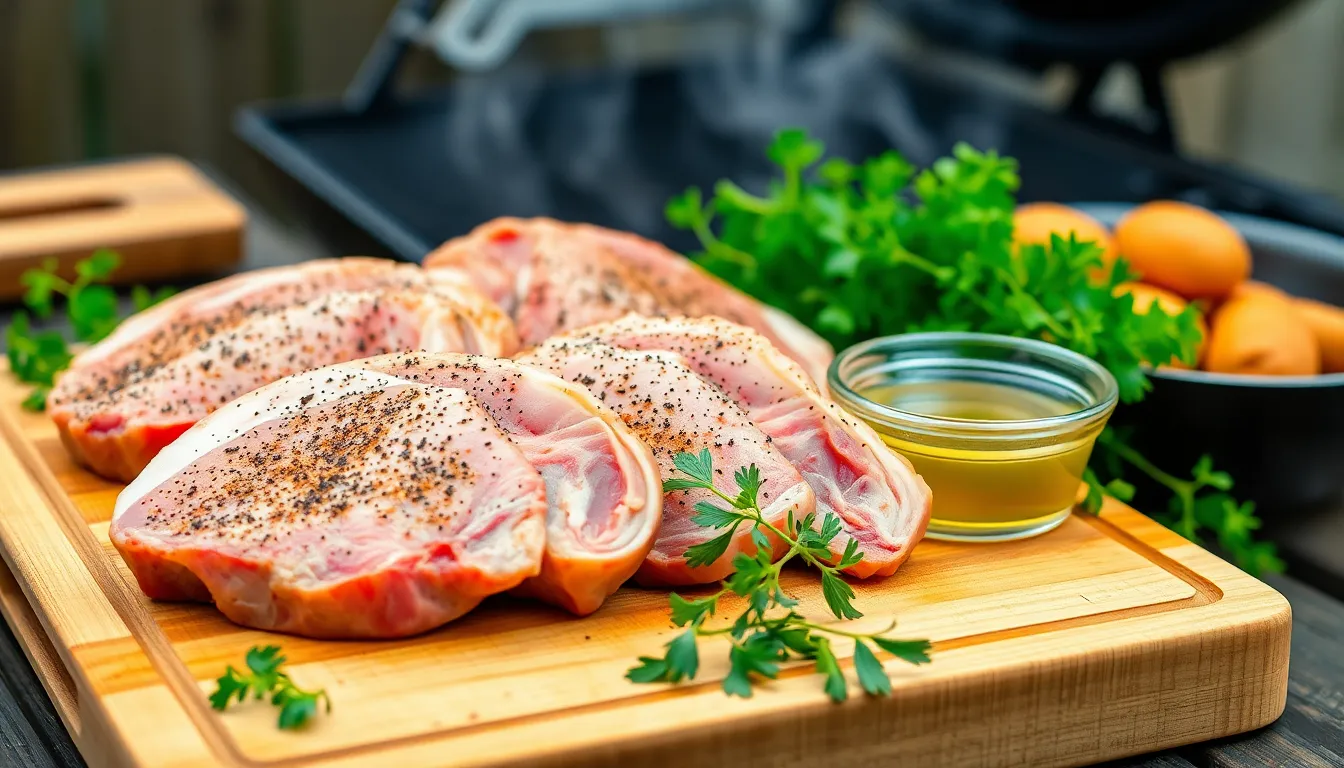
Getting our pork chops ready properly sets the foundation for BBQ success. We’ll transform ordinary cuts into extraordinary grilled masterpieces by focusing on three key preparation techniques.
Essential Brining Techniques
Salt-based marinades work similarly to traditional brining by tenderizing the meat and helping our pork chops retain moisture during grilling. We recommend applying a salt-containing rub or marinade for at least 1 hour before cooking, though overnight treatment delivers even better results. This technique penetrates the meat fibers and creates a moisture barrier that prevents our chops from drying out on the grill.
Creating our own brine substitute involves combining coarse salt with complementary seasonings that enhance the pork’s natural flavors. We’ve found that incorporating salt into marinades achieves the same tenderizing effect as traditional wet brining without the hassle of large containers. The salt draws out moisture initially, then the meat reabsorbs it along with our chosen flavors.
Dry Rub Seasoning Blends
A simple yet effective dry rub includes salt, garlic, lemon zest, and rosemary for bold flavor that complements our BBQ pork chops perfectly. We balance salty and sweet spices carefully to avoid overpowering the meat’s natural taste. Our favorite combination delivers restaurant-quality seasoning without complex ingredients.
Building layers of flavor starts with selecting spices that work harmoniously together on grilled pork. We apply dry rubs generously, ensuring complete coverage on all surfaces of our chops. The key lies in finding the right balance between bold seasonings and the pork’s inherent richness.
Marinating Time Guidelines
Marinating our pork chops for at least 1 hour allows flavors to penetrate the surface, though overnight marination delivers ideal tenderness and flavor absorption. We’ve discovered that sirloin and shoulder cuts benefit from longer marinating periods up to 8 hours due to their higher fat content and connective tissue. This extended time helps render fat and enhances overall tenderness.
Timing our marinades correctly ensures optimal flavor development without breaking down the meat’s texture. We monitor thicker cuts more carefully since they require additional time for seasonings to reach the center. Room temperature marinating for the final 30 minutes before grilling promotes even cooking throughout our pork chops.
Master the Perfect BBQ Temperature and Timing

Achieving perfect BBQ pork chops depends on precise temperature control and proper timing techniques. We’ll guide you through the essential temperature settings and timing methods that transform ordinary chops into restaurant quality masterpieces.
Ideal Grill Temperature Settings
Set your grill to medium high heat between 350°F and 450°F for optimal results. Most pitmasters recommend maintaining temperatures around 375°F to 425°F, which provides the perfect balance of searing capability and controlled cooking.
Start by creating a two zone cooking setup on your grill. Position your pork chops directly over the hottest section (above coals or burners) for initial searing. This high heat zone should reach the upper end of your temperature range for maximum browning effect.
Sear each side for 3 to 4 minutes to develop that coveted crust. The direct high heat creates the Maillard reaction that produces deep flavors and appealing color. Keep your grill lid open during this crucial searing phase to monitor progress closely.
Move the chops to indirect heat after searing to finish cooking. Transfer them to the cooler section of your grill where temperatures hover around 350°F. This prevents burning while allowing the interior to reach proper doneness.
Internal Temperature for Food Safety
Target an internal temperature of 145°F for safe consumption according to USDA guidelines. Insert your meat thermometer into the thickest part of the chop, avoiding contact with bone for accurate readings. The meat may appear slightly pink at this temperature but remains completely safe to eat.
Pull your chops at 135°F for optimal juiciness and texture. Allow them to rest for 5 to 10 minutes, during which carryover cooking raises the internal temperature to the safe 145°F threshold. This technique preserves maximum moisture while ensuring food safety compliance.
Avoid exceeding 160°F internal temperature to prevent dryness. While some prefer medium doneness at this higher temperature, the risk of tough, dry meat increases significantly. Monitor your thermometer closely as pork chops can quickly overcook.
Cooking Time by Thickness
| Chop Thickness | Searing Time (per side) | Total Cooking Time | Internal Temp Target |
|---|---|---|---|
| 1 inch | 3-4 minutes | 12-16 minutes | 145°F |
| 1.5 inches | 4-5 minutes | 16-20 minutes | 145°F |
| 2 inches | 5-6 minutes | 20-24 minutes | 145°F |
Cook 1 inch thick pork chops for 4 to 8 minutes per side at 400°F. The exact timing depends on your grill’s heat distribution and the exact cut you’re preparing. Standard bone in chops typically require 6 to 8 minutes per side for proper doneness.
Increase cooking time to 6 to 8 minutes per side for thicker cuts. Chops measuring 1.5 to 2 inches need additional time to heat through completely. Use the two zone method with 3 minutes of searing followed by 12 to 14 minutes of indirect cooking.
Keep your grill lid closed during the indirect cooking phase. This maintains consistent temperatures and promotes even heat circulation around the meat. Only open the lid to check internal temperature or apply glazes during the final 10 minutes of cooking.
Select the Best BBQ Sauce for Pork Chops
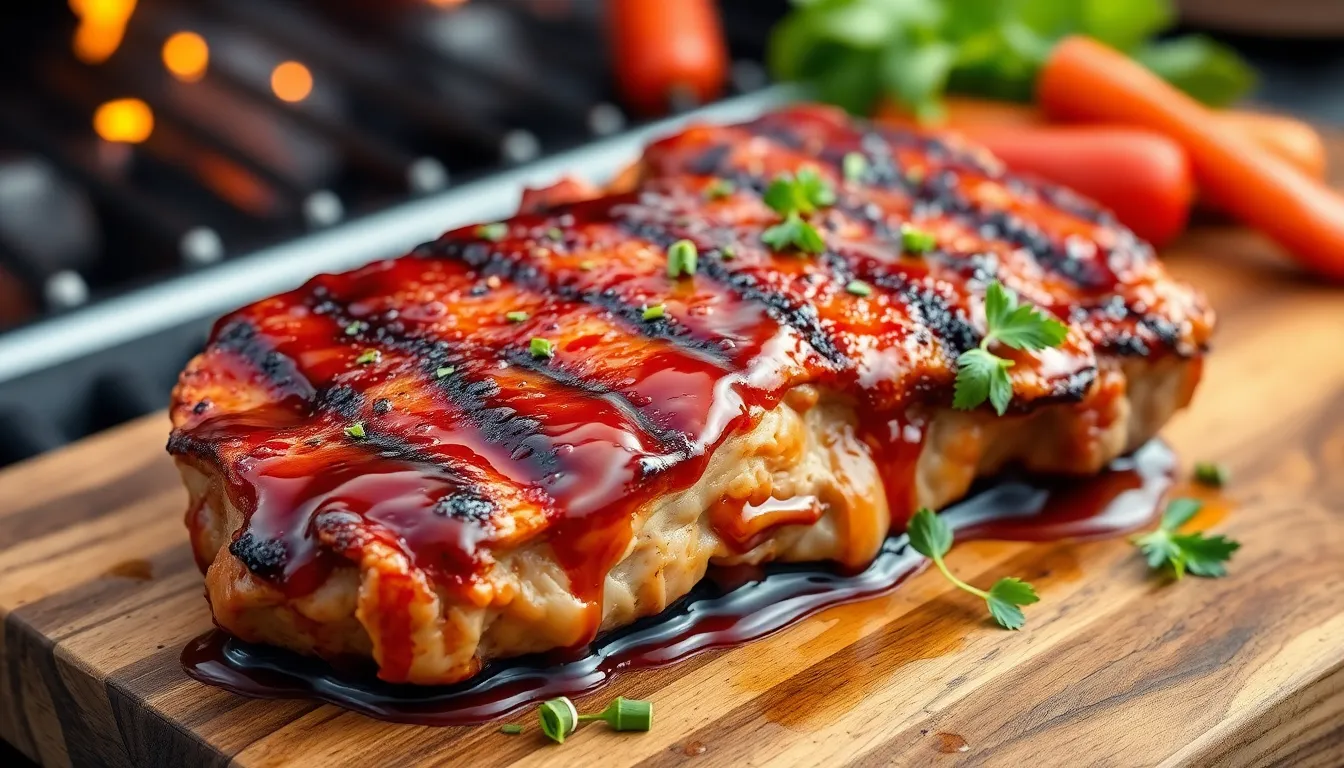
Finding the right BBQ sauce transforms ordinary pork chops into extraordinary flavor experiences. We’ll guide you through the best sauce options and proper application techniques to maximize taste and juiciness.
Sweet and Tangy Options
Classic sweet and tangy BBQ sauces deliver the perfect balance that complements pork’s natural flavor profile. These sauces commonly feature ketchup, brown sugar, apple cider vinegar, and mustard as their foundation ingredients.
Homemade sweet BBQ sauce creates exceptional results when you combine ketchup, brown sugar, Worcestershire sauce, apple cider vinegar, Dijon mustard, mesquite seasoning, garlic powder, salt, and pepper. This blend produces a flavorful, juicy coating that enhances grilled pork chops perfectly.
Carolina Gold BBQ Sauce offers a mustard-based tangy alternative that pairs beautifully with marinated, char-grilled pork chops. We recommend mixing yellow mustard, honey, apple cider vinegar, brown sugar, ketchup, Worcestershire sauce, garlic powder, salt, and hot sauce for this distinctive regional favorite.
Brown sugar and lime juice combinations work exceptionally well for pan-fried pork chops, creating a sweet glaze that doubles as a flavorful gravy base.
Smoky and Spicy Varieties
Smoky BBQ sauces infuse deep, complex flavors through ingredients like mesquite seasoning, smoked paprika, and cayenne pepper. These additions create layers of heat and aromatic depth that elevate your pork chops.
Molasses-based BBQ sauce provides rich, bold flavors when you combine dark molasses, ketchup, chili garlic sauce, sesame oil, apple cider vinegar, and grated garlic. This combination offers perfect richness with a mild kick that’s ideal for pan-seared pork loin chops.
Spicy marinades enhance the heat factor by incorporating cayenne pepper and fresh garlic, adding both fire and aromatic elements to your finished dish.
When to Apply Sauce During Cooking
Timing your sauce application prevents burning while building maximum flavor layers on your pork chops. We recommend applying BBQ sauce after the initial grilling or searing phase, typically after cooking the chops for a few minutes on one side.
Brush the sauce onto the chops, then continue cooking while flipping and reapplying sauce to create multiple flavor layers without charring the sugars prematurely. This technique keeps pork chops juicy and prevents premature burning.
Rest your pork chops for about 5 minutes after cooking to retain maximum juiciness before serving.
| Sauce Type | Key Ingredients | Cooking Application | Flavor Profile |
|---|---|---|---|
| Sweet & Tangy | Ketchup, brown sugar, mustard, apple cider vinegar | Brush midway and near end of cooking | Balanced sweet & sour |
| Smoky & Spicy | Molasses, chili garlic sauce, cayenne, mesquite | Apply after searing, reapply sparingly | Rich, smoky, mildly spicy |
Avoid Common BBQ Pork Chop Mistakes
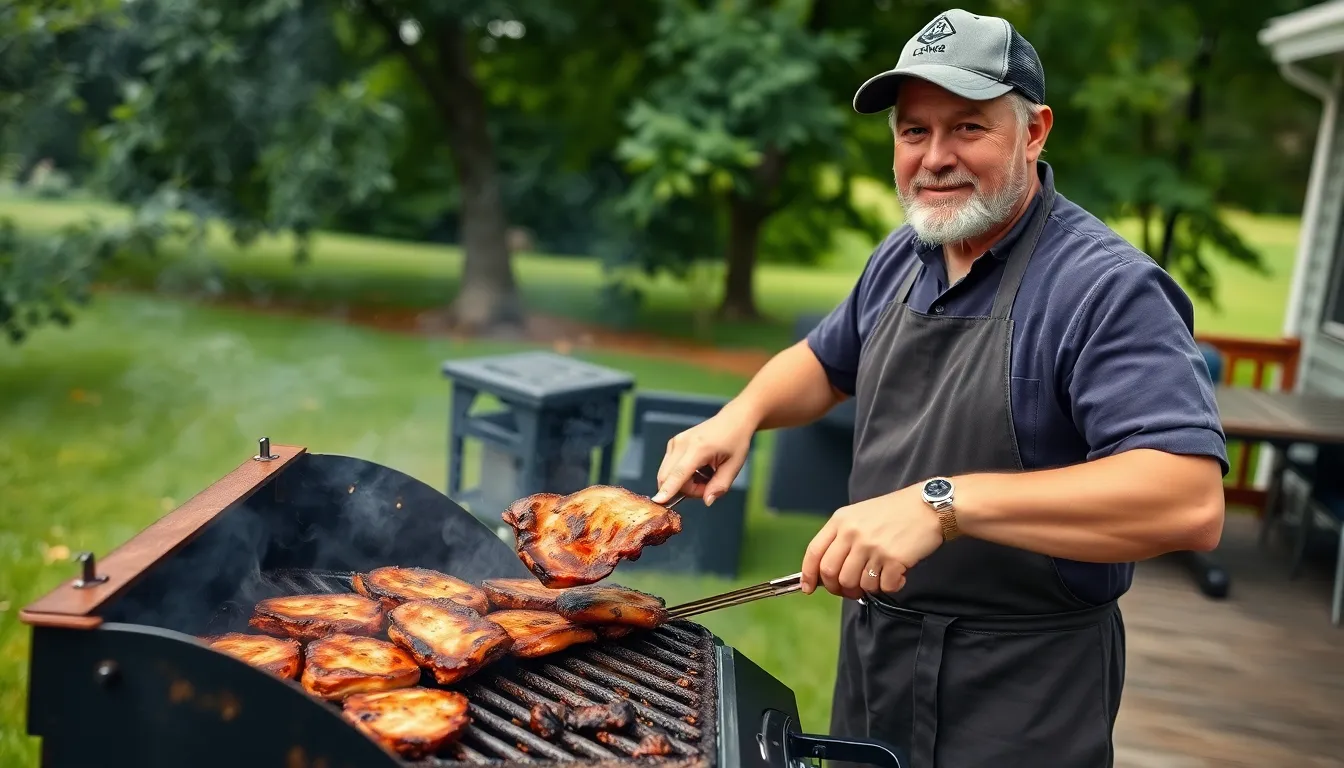
We’ve all been there – beautiful pork chops that looked perfect on the grill but turned out disappointing. Learning from these common pitfalls will transform your BBQ game and guarantee juicy results every time.
Preventing Dry, Overcooked Meat
Temperature control is the foundation of perfectly cooked BBQ pork chops. We recommend pulling your chops off the grill when they reach an internal temperature of 145°F, as cooking beyond this point leads to dry, tough meat that nobody wants to eat.
Timing plays a crucial role in maintaining moisture throughout the cooking process. Most 1-inch thick chops need approximately 6-8 minutes per side on medium heat, but thickness variations require adjustments to prevent overcooking.
BBQ sauce application timing prevents both burning and dryness:
| Sauce Type | Application Time | Benefits |
|---|---|---|
| Sweet BBQ sauce | Last 5 minutes | Prevents sugar burning |
| Tangy vinegar sauce | Last 3 minutes | Maintains acidity |
| Molasses-based sauce | Last 7 minutes | Develops caramelization |
Meat thermometers eliminate guesswork and ensure consistent results across different chop thicknesses. We always insert the thermometer into the thickest part of the chop, avoiding contact with bone for accurate readings.
Managing Flare-Ups and Hot Spots
Flare-ups occur when fat drips onto hot coals or burners, creating sudden flames that can char your pork chops. We maintain moderate grill temperatures and create indirect heat zones to minimize these dangerous flame bursts.
Strategic placement prevents uneven cooking:
- Position thicker chops over cooler zones after initial searing
- Move chops away from direct flame sources when flare-ups occur
- Rotate chops 90 degrees halfway through cooking for even heat distribution
- Keep a spray bottle filled with water nearby for emergency flame control
Excessive sugar in marinades contributes to burning and flare-up incidents. We avoid overly sweet sauces during the initial cooking phases, saving them for the final glazing moments instead.
Oil selection matters when preventing grill flare-ups and sticking issues. Light coating of high-heat oils like canola or grapeseed on clean grates creates a non-stick surface without excessive dripping.
Resting Time Before Serving
Resting allows meat juices to redistribute throughout the pork chops after cooking stress. We cover our cooked chops loosely with foil and wait at least 5 minutes before cutting, ensuring maximum moisture retention.
Proper resting technique maximizes juiciness:
- Remove chops from direct heat immediately after reaching 145°F
- Tent loosely with aluminum foil to maintain warmth
- Allow 5-10 minutes for juice redistribution
- Avoid cutting immediately, which causes juice loss
Serving immediately after cooking causes precious juices to run out onto the plate instead of staying in the meat. This simple waiting period makes the difference between dry, disappointing chops and restaurant-quality results that’ll have your guests asking for seconds.
Internal temperature continues rising during the resting period, typically adding 3-5 degrees to the final temperature. We factor this carryover cooking into our timing to achieve perfect doneness without overcooking.
Enhance Your BBQ with Perfect Side Dishes
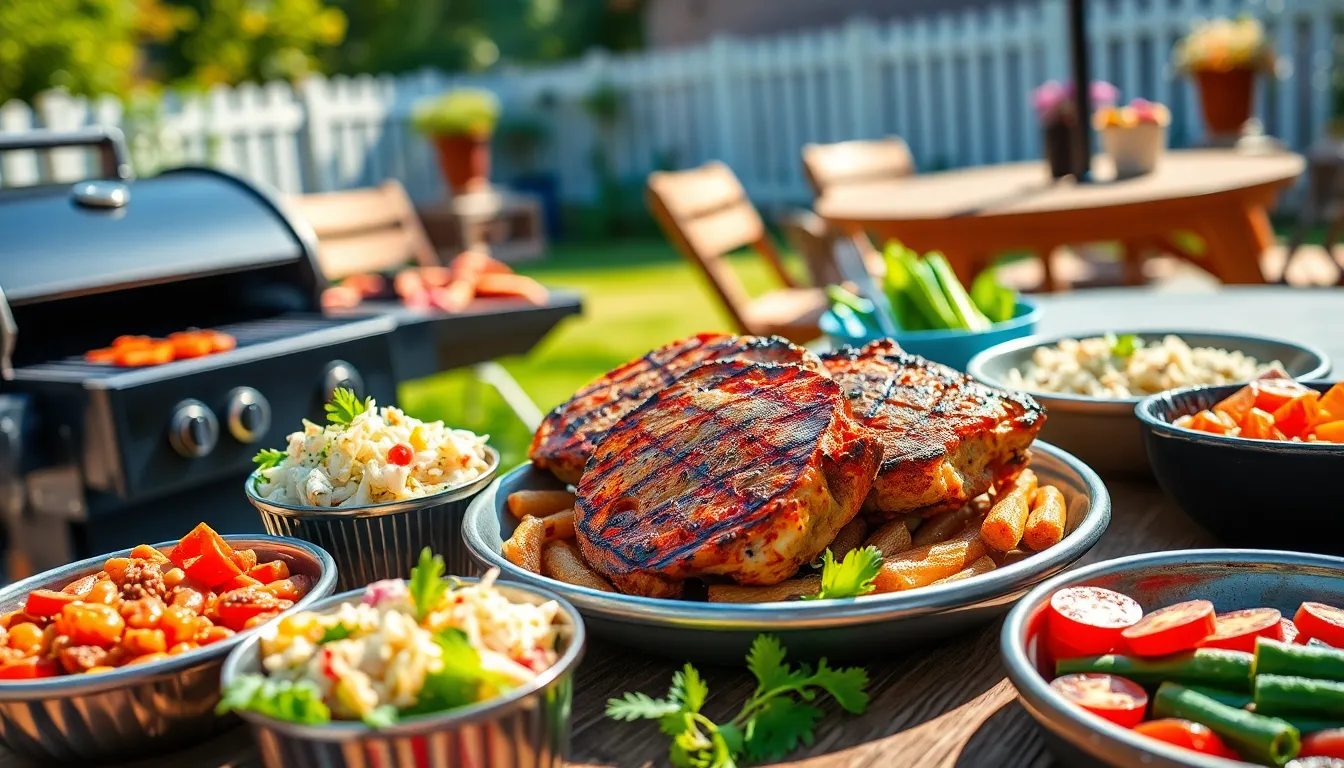
Perfect side dishes transform your BBQ pork chops from a simple meal into a memorable feast. We’ve curated the best accompaniments that complement the rich, smoky flavors of your perfectly grilled chops.
Classic BBQ Accompaniments
Coleslaw leads our essential BBQ sides with its creamy texture and tangy crunch that cuts through the richness of pork. We recommend preparing it with a vinegar-based dressing to balance the meat’s fat content perfectly.
Baked beans bring sweet and savory depth to your BBQ spread, offering protein and fiber that pair naturally with grilled pork. Traditional recipes featuring molasses and brown sugar echo the flavors we use in our BBQ marinades.
Grilled vegetables round out the classic trio by adding smoky char flavors that mirror your pork chops. Bell peppers, zucchini, and onions develop caramelized edges when cooked over the same grill temperature we use for our chops.
Vegetable Sides That Complement Pork
Roasted bell peppers deliver natural sweetness that enhances pork’s mild flavor profile without competing for attention. We suggest using red and yellow varieties for visual appeal and varying sugar levels.
Grilled corn on the cob provides satisfying texture contrast with its crisp kernels and slight char from direct heat cooking. Brushing with herb butter creates flavor bridges to your seasoned pork chops.
Sautéed spinach offers nutrient density while maintaining the earthy flavors that complement pork’s richness. Garlic and lemon additions mirror the seasoning profiles we recommend for our dry rubs.
Refreshing Salads for Balance
Mixed greens salad provides cooling relief from the intense flavors of BBQ pork, especially when dressed with light vinaigrette. We suggest adding fresh herbs like rosemary that echo our pork chop seasonings.
Cucumber and tomato salad delivers hydrating crunch that cleanses the palate between bites of rich, marinated pork. Simple olive oil and vinegar dressing maintains the fresh, clean taste profile.
Fruit salad introduces natural sweetness that complements the caramelized edges of properly grilled pork chops. Stone fruits like peaches and plums work particularly well with the smoky BBQ flavors we’ve developed.
Store and Reheat Leftover BBQ Pork Chops

Even the most perfectly grilled BBQ pork chops can become tomorrow’s delicious meal with proper storage and reheating techniques. We’ll show you how to maintain that juicy, flavorful quality you worked so hard to achieve.
Proper Storage Methods
Cool your BBQ pork chops to room temperature within two hours of cooking to prevent bacterial growth. Never leave cooked pork sitting out longer than this critical timeframe, as harmful bacteria multiply rapidly in the temperature danger zone.
Transfer the cooled chops into airtight containers or wrap them tightly in aluminum foil or plastic wrap. This prevents the meat from drying out and absorbing unwanted refrigerator odors that can compromise the BBQ flavor.
Refrigerate your wrapped pork chops immediately and consume them within 3-4 days for optimal quality and safety. Label containers with the cooking date so you can track freshness accurately.
Freeze leftover chops in freezer-safe bags or containers for longer storage periods. Vacuum sealing works best for preserving that fresh-grilled taste and preventing freezer burn that can ruin your carefully crafted BBQ masterpiece.
Best Reheating Techniques
Oven reheating produces the most consistent results for maintaining moisture and flavor. Preheat your oven to 250-275°F, place chops in an oven-safe dish, cover with foil, and warm for 15-20 minutes until heated through.
Stovetop reheating offers excellent control over the warming process. Heat your chops covered in a skillet over low heat with a splash of water or broth, turning occasionally to ensure even heating without drying out the meat.
Microwave reheating works when you’re short on time but requires careful attention. Use medium power settings and cover chops with a microwave-safe lid or damp paper towel, heating in short intervals while checking frequently to avoid overcooking.
Gentle heat application prevents the proteins from toughening during reheating. Avoid high temperatures that can quickly transform your tender BBQ pork chops into dry, chewy disappointments.
Food Safety Guidelines
Ensure your initial cooking reaches an internal temperature of at least 145°F as recommended by food safety experts. This temperature eliminates harmful bacteria while maintaining the juicy texture we all love in BBQ pork chops.
Refrigerate leftovers within two hours of cooking to prevent dangerous bacterial growth that can cause foodborne illness. Hot summer weather reduces this safe window to just one hour, so act quickly after your BBQ session.
Heat rewarmed leftovers to 165°F to guarantee safety when serving again. Use a meat thermometer to verify this temperature, especially when reheating thicker chops that may heat unevenly.
Discard any leftovers showing signs of spoilage including off smells, slimy textures, or unusual colors. When in doubt, throw it out – no BBQ pork chop is worth risking your health or that of your family.
Conclusion
We’ve covered everything you need to transform ordinary pork chops into BBQ masterpieces that’ll have your neighbors asking for your secrets. From selecting the perfect cut to nailing that ideal 145°F internal temperature these techniques will make you the grill master you’ve always wanted to be.
Remember that great BBQ pork chops aren’t just about the meat—they’re about the complete experience. The right sauce application timing and those perfectly paired sides we discussed will elevate your entire meal from good to unforgettable.
Now it’s time to fire up that grill and put these proven methods to work. Your family and friends are going to be amazed at the juicy flavorful results you’ll achieve with these restaurant-quality techniques.
Frequently Asked Questions
What is the best cut of pork chop for BBQ grilling?
Bone-in ribeye and T-bone chops are ideal for BBQ because they retain moisture and offer superior flavor. These cuts should be 1 to 1.5 inches thick for optimal cooking control. Center-cut chops provide versatility, while porterhouse chops offer variety with both tenderloin and loin portions. For budget-conscious grillers, shoulder chops deliver rich taste at a lower cost.
How long should I marinate pork chops before grilling?
Marinate pork chops for a minimum of 1 hour, though overnight treatments yield better results. For salt-based marinades or brines, allow at least 1 hour for flavor penetration and meat tenderizing. Fattier cuts like sirloin and shoulder benefit from longer marinating times to fully absorb the seasonings and achieve maximum flavor enhancement.
What temperature should I grill pork chops at?
Set your grill to medium-high heat between 375°F and 425°F for optimal results. Use a two-zone cooking setup: start with direct high heat for searing, then move to indirect heat to finish cooking. This temperature range ensures proper searing while preventing the meat from drying out during the cooking process.
What internal temperature should pork chops reach?
Cook pork chops to an internal temperature of 145°F for food safety. For maximum juiciness, pull the chops from the grill at 135°F and let carryover cooking bring them to the safe temperature. Use a meat thermometer for accurate readings and avoid overcooking, which leads to dry, tough meat.
When should I apply BBQ sauce during grilling?
Apply BBQ sauce after the initial searing phase to prevent burning and charring. Brush sauce on during the last 5-10 minutes of cooking, allowing it to caramelize without burning. Reapply as needed, but avoid adding sugary sauces too early in the cooking process to maintain optimal flavor and appearance.
How long should pork chops rest after grilling?
Rest grilled pork chops for 5-10 minutes after cooking to retain maximum juiciness. Cover them loosely with foil during the resting period. This allows the juices to redistribute throughout the meat, ensuring tender, moist chops when served. Proper resting is crucial for achieving restaurant-quality results.
How do I prevent pork chops from sticking to the grill?
Use high-heat cooking oils like avocado or grapeseed oil to prevent sticking and minimize flare-ups. Ensure your grill grates are clean and properly preheated before placing the chops. Oil the grates lightly or brush oil directly on the meat. Avoid moving the chops too soon to allow proper searing.
How should I store leftover BBQ pork chops?
Cool pork chops to room temperature within two hours, then store in airtight containers in the refrigerator for up to 3-4 days. For longer storage, freeze for up to 3 months. Label containers with dates and ensure proper wrapping to prevent freezer burn and maintain quality.
What’s the best way to reheat leftover pork chops?
Reheat pork chops gently in a 325°F oven covered with foil, or use low heat on the stovetop with a splash of broth. For microwave reheating, use 50% power and cover with a damp paper towel. Always reheat to an internal temperature of 165°F and avoid high heat to prevent drying out.
What are the best side dishes for BBQ pork chops?
Classic sides include coleslaw, baked beans, and grilled vegetables that complement the rich pork flavors. Grilled corn on the cob, roasted bell peppers, and sautéed spinach provide excellent balance. Fresh fruit salads and green salads offer palate-cleansing contrast, while potato salad and mac and cheese round out the traditional BBQ experience.

